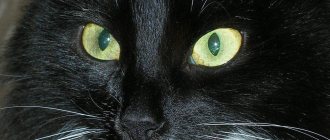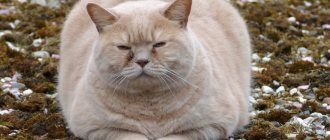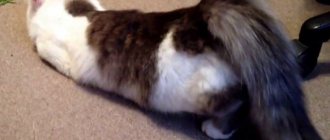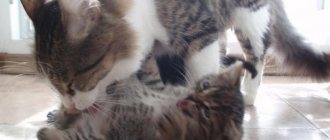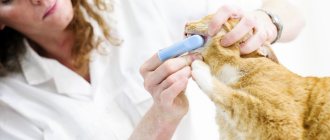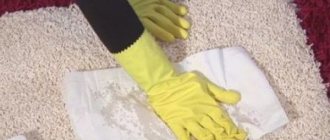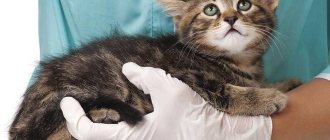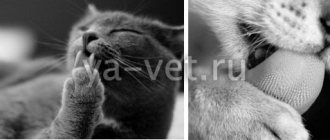Black spots in cats do not occur very often and may be the result of improper care. Sometimes such symptoms indicate disorders in the body that need to be identified as early as possible. A timely visit to a doctor will help determine the cause, and an integrated approach to treatment will eliminate the problem.
- 2 Causes and triggering factors
2.1 Why acne occurs in animals - video
- 4.1 Pharmacy and folk remedies
4.1.1 How to rid a cat of acne - video
What are blackheads in cats and why are they dangerous?
Blackheads (acne) are clogged sebaceous glands. The characteristic dark head occurs when sebum oxidizes. The appearance of such symptoms in an animal may indicate disturbances in the functioning of the body, the presence of parasites. Such a problem cannot be ignored.
Black spots can trigger the occurrence of furunculosis, which is characterized by a purulent process occurring in the inflamed sebaceous gland. This condition is dangerous for the pet’s health and can contribute to the spread of infection. Outdoor animals are most susceptible to acne, but comedones can also occur in indoor cats.
Blackheads in cats are caused by blocked sebaceous glands.
Malfunctions of the sebaceous glands also appear in completely healthy pets. If a cat likes to play outside, a small amount of dirt gets into the mouth and, mixing with sebum, clogs the duct. Most often, comedones are localized on the chin.
When acne occurs, the sebaceous gland becomes inflamed and expands. If the pore is not cleaned in time, bacteria will begin to multiply, which will cause the appearance of pus.
The cat has black dots on his chin under his fur: what are they?
Sebaceous glands are located on a cat's chin. When the ducts are clogged, the secretion remains inside and is subject to bacterial contamination. A black abscess forms. Fleas leave similar spots. They feed on blood, and their feces are undigested red blood cells. Flea excrement is easily removed by combing, but the spots cannot be removed.
At first, acne does not bother animals, however, over time, the epithelium becomes keratinized, sloughed off, and skin defects form. Bacteria that do not harm a cat with an intact skin begin to multiply. The affected area itches and new scratches form.
Gradually the acne spreads. They can be seen on the lips, at the base of the ears, in the back, tail, and around the anus.
Hairless cat breeds are predisposed. A related factor is hormonal imbalances. Neutered men do not develop acne.
Comedones appear on the chin in the form of whitish or black dots. As the pathological process develops, acne appears on the tail, at the base of the ears, corners of the lips, on the stomach, thighs, and near the anus. Black dots look like flea excrement, but they cannot be removed by combing.
At first, acne does not bother your pet. However, the hair falls out around them, banal microflora gets in and multiplies. Inflammation develops, accompanied by itching. The animal scratches the inflamed area, a new portion of the infection enters, fungi attach, and the pathological condition worsens. Hair falls out on the affected areas, the exudate dries out, and crusts form.
Be sure to read:
The cat itches to the point of sores on the neck and head, to the point of hair loss, but there are no fleas: how to treat the itching
The cause of the disease is determined by a veterinarian.
Diseases with similar symptoms are excluded:
- Allergy to food or external irritants;
- Demodectic mange;
- Flea dermatitis;
- Ringworm.
Causes and provoking factors
The cause of the problem may be the individual characteristics of the body. At the same time, the owner needs to properly care for the pet, which will reduce the number of black spots. An additional factor in the occurrence of acne in the chin area is that this area has the least amount of hair. This makes it easier for bacteria to get into the pores.
Additional factors:
- poor nutrition;
- hormonal disorders;
- decreased immunity;
- liver diseases;
- pathologies of the sebaceous glands.
When the sebaceous gland is blocked, the excretory duct may become inflamed, which causes pain.
The problem can also occur on the hips, elbows and eyelids. Inflamed sebaceous glands can cause discomfort to the animal, causing pain. The skin in the acne area becomes red and sometimes swells slightly. Chronic intoxication, which occurs as a result of infection of the body with parasites, can provoke the appearance of black spots. At the same time, the waste products of helminths contribute to disruption of the functioning of various systems.
Attention! If a cat has acne, it is necessary to check the condition of the paraanal glands, which are located next to the anus. If they are inflamed, you should definitely consult a doctor. Otherwise, acne will appear again and again.
Why acne occurs in animals - video
Diagnostics
The most accurate method, which makes it possible to make a diagnosis with 100% probability, is growing a culture of the pathogen on a special nutrient medium, followed by microscopy. The problem is that fungi take a very long time to grow. Therefore, for “emergency” diagnostics, the so-called Wood’s lamp is often used. The idea is that some strains of dermatomycetes begin to fluoresce under UV radiation. True, this method does not always work.
In addition, the diagnosis is made on the basis of data obtained from conventional microscopy of hair samples and scrapings from the animal’s skin. In this case, it is highly advisable to tint the samples and conduct the study using oil lenses. In this case, the image in the field of view is more contrasting, and therefore it is much easier to detect the pathogen.
Treatment can only be local.
- Use YaM ointment, sulfur ointment, salicylic acid.
- Enilconazole-based shampoos are recommended.
- If the animal’s condition is severe and there is a suspicion of a concomitant bacterial infection, econazole and clotrimazole are also prescribed in oral form, supplemented with broad-spectrum antibiotics.
It is difficult to treat cats with advanced symptoms; therapy takes much more time than if the owner had only just discovered the first symptoms of infection. But what’s much worse is that in advanced cases, the pet’s immune system suffers greatly, which is why the cat has to be treated for both fungus and infections.
Excessive grooming of the cat : frequent bathing with shampoo, constant cleaning of the ears with cotton swabs, and other grooming procedures contribute to the development of fungi.
Fungus in cats manifests itself in various symptoms.
Some of them can be detected immediately, while others only after laboratory tests.
If you suspect this disease, it is necessary to isolate the cat from contact with other animals until the diagnostic results are obtained.
TABLE OF CONTENTS:
If you suspect a fungus in cats, its symptoms should be as follows:
- frequent and prolonged combing of a certain area;
- ear fungus is characterized by frequent scratching and pressing of the ears, shaking of the head;
- depressed state;
- refusal to eat;
- cough.
There are 2 types of fungus in cat breeds:
- Formed on the skin and mucous membranes of an animal: ringworm and yeast stomatitis.
- Systemic fungi that affect the internal organs of the cat.
Many people know first-hand what ringworm looks like. Its distinctive features are a rounded area of skin without hair, the edges of which have a bright red color.
With yeast stomatitis, increased salivation appears, an unpleasant odor from the oral cavity, the color of the mucous membrane changes, and bleeding wounds appear in the mouth.
Systemic forms of the fungus are very rare in cats.
These include the following types:
- Cryptococcosis . It is formed by a yeast-like fungus found in the soil layer of the earth and in bird droppings.
Characterized by coughing, sneezing, difficulty breathing, bloody discharge from the nose, and lumps under the skin.
In the advanced form, the nervous system is affected, leading to loss of vision and seizures.
If left untreated, it can lead to meningitis and death of the cat. This is one of the most difficult fungal diseases to treat. Histoplasmosis . It is very dangerous, since the symptoms of infection are similar to those of other diseases, so it can be difficult to immediately make a correct diagnosis.
Appetite is disrupted, accompanied by weight loss, body temperature rises, weakness and apathy occur, and the eyes and skin are affected. Treatment must be carried out in the early stages of the disease.
- Blastomycosis . They affect the respiratory system, skin, eyes and brain. Dogs and humans can also get these diseases.
- Actinomycosis. It is caused by a radiant type of fungus that affects the mouth, neck, chin, area around the nose and lips, groin, and chest.
When fungus forms on the face and neck, a slight rise in temperature occurs, and the movement of the jaw and chewing muscles is limited.When the chest and abdominal area are affected, a high temperature, expectorant cough with discharge, and loss of strength are formed. Ear fungus . The most common infection, which is very easy to determine by observing the cat’s behavior.
The animal constantly and for a long time scratches its ear with its paw, experiencing pain, and shakes its head or turns to the sides. A large amount of wax forms in the ears.
If left untreated, the fungus enters the middle ear, causing meningitis, and can lead to the death of the animal.
- Mycetoma . It affects the skin and tissue underneath it, sometimes the skeletal system. Its granules are localized on the toes and near the nails, where its new growths appear and grow.
- Candidiasis. Affects the skin and mucous membranes of the mouth. Formed in the form of a white coating or scaly wounds.
Appears during prolonged treatment of an animal with antibiotics, intestinal tract infections, and pulmonary diseases. Mycosis. This infection affects cats with reduced immunity. Main symptoms: redness of the skin, spots on the abdomen, ears and genitals.Hair loss and dandruff occur.
- Malassezia . Manifested by severe baldness.
Important! Many fungal diseases do not cause any special problems for the cat, but greatly reduce the immune system. Because of this, the cat becomes susceptible to dangerous viruses.
How to distinguish acne from other pathologies
It is important to be able to distinguish black dots from waste products of blood-sucking parasites and their larvae, as well as from droplets of dried blood that could appear as a result of trauma to the skin. Differentiating one condition from another is quite simple. You need to carefully try to detach the black lump. If it comes off easily from the skin and is dark brown in color, then it is dried blood.
Dried blood on a cat's chin looks like inflammation of the sebaceous glands
It is important to inspect the surface for scratches and small wounds. If the black dot has separated from the skin, but has a dense consistency and is difficult to press, then most likely these are waste products of ticks or fleas. Less commonly, these can be larvae of blood-sucking parasites. Acne is indicated by the inability to separate the blackhead from the skin. At the same time, it is as if soldered into the mouth of the sebaceous gland.
Flea larvae in cats can be confused with blackheads
If, in addition to acne, the animal has other symptoms, such as lethargy, appetite disturbances, diarrhea, then you should definitely consult a doctor.
Methods for eliminating comedones in pets
You can eliminate blackheads in a cat using an integrated approach to the problem. To do this, you should normalize the pet’s diet, eliminating everything harmful to its body, and also carry out deworming, that is, get rid of worms using one of the specialized drugs: Milbemax, Drontal, Dirofen, etc. You can also use topical pharmaceuticals for treatment. applications. Traditional methods will help complement therapy and make it more effective.
To eliminate acne, first of all, it is necessary to deworm your pet using the drug Milbemax or other similar products.
You should start eliminating comedones only after consulting a doctor, since the cause of the pathology can be serious disturbances in the functioning of the body.
Pharmacy and folk remedies
To eliminate acne in adult animals, the drug Percutan can be used. This medication has antibacterial properties, due to which it prevents the proliferation of pathogenic microflora and eliminates the inflammatory process. The medicine is available in the form of a solution for external use. It should be applied with a cotton swab 2 times a day to the affected areas of the skin. The course of treatment should be from 4 to 10 days.
Percutan has an antibacterial effect
Also, the area affected by blackheads can be treated with calendula tincture, which has anti-inflammatory and antiseptic properties. This product can regulate the functioning of the sebaceous glands, reducing fat production. The tincture should be used once a day. The most convenient way to apply the liquid is with a cotton swab. The treatment course should not exceed 4–5 days, since the tincture contains alcohol, which can dry out the skin.
Calendula tincture eliminates inflammation
For treatment, you can also use Furacilin solution, which is active against a wide range of microorganisms. At the same time, bacteria and inflammation are eliminated, due to which comedones gradually disappear. 1 tablet of Furacilin must be dissolved in 1 glass of warm water. Treat the affected area with the resulting liquid 3 times a day for a week.
Furacilin produces an antiseptic effect
It is also possible to use retinol (vitamin A) in the form of ointments and creams. These products include: Differin, Clenzit and others. These drugs should be used with caution, as they can cause severe skin irritation. Apply the ointment with a cotton swab in a thin layer every other day for a week. If your pet experiences itching and redness of the skin, then it is recommended to abandon this method of treatment.
Clensite helps eliminate acne, but can cause irritation
Another effective remedy for eliminating the problem is a solution of methylene blue, which can be purchased at a pharmacy. It soothes the skin by eliminating overactive sebaceous glands. You can treat the affected areas with this product no more than once a day for 3-4 days. If during this time the blackheads have not disappeared, then it is recommended to use another method, since methylene blue slightly dries out the skin.
Methylene blue relieves acne and heals skin
To get rid of comedones, you can also use Chlorhexidine. It eliminates bacteria and excess sebum, while blackheads decrease in size and then completely disappear. The solution should be used no longer than 4–5 days, because it can dry out the epidermis. Wipe the skin with this product 2 times a day using a cotton pad. It is advisable to do this after the pet has eaten.
Chlorhexidine should not be used for more than 5 days
For treatment, you can also use Elite shampoo, which is designed specifically for the treatment and prevention of skin diseases in cats and dogs. This product contains chlorhexidine, plantain and celandine extract, glycerin and provitamin B with allantoin. The shampoo is easily applied to the coat, foams and is washed off with warm water. After just a few uses, acne will disappear.
Elite shampoo is designed specifically for the treatment of skin diseases
In advanced cases, when a secondary infection occurs and suppuration occurs, it is recommended to use tetracycline ointment, which is active against a wide range of pathogenic microorganisms. This remedy should be applied to the site of inflammation 2 times a day. The course of treatment varies from 7 to 10 days. If at the end of therapy there is no result, then you should definitely consult a doctor.
Tetracycline ointment is active against a wide range of bacteria
An excellent folk remedy that helps solve this problem is tar soap. You can use it without fear. This remedy rarely causes allergic reactions, but it eliminates inflammation, fungal and bacterial infections, and also promotes tissue regeneration. Tar soap should be applied to the affected area once a day for a week. In this case, the skin should be pre-moistened with water. After application, you need to wait 5 minutes and then rinse off the product.
Tar soap does not cause allergic reactions
A good effect is produced by chamomile infusion, which eliminates inflammation and skin itching. You will need 1 tbsp. l. dry raw materials, which needs to be poured with a glass of boiling water and left for 1 hour. Then filter the liquid and apply it to the acne area 4 times a day using a cotton pad. The course of treatment is from 10 to 14 days.
Chamomile infusion helps you get rid of blackheads faster
Attention! Under no circumstances should you squeeze your pet's acne. Otherwise, you can provoke increased inflammation and the addition of infection, which will lead to the occurrence of furunculosis.
A friend has a white cat that has black spots on its chin. No one would have thought that animals could also have such a problem. A friend was scared at first because she thought it was not acne, but some kind of serious disease, so she immediately took her pet to the doctor. After examination, the vet said that these were just black dots. Prescribed Chlorhexidine and medicated shampoo. We managed to get rid of the problem in less than a week. Additionally, the doctor recommended paying attention to your pet’s diet.
How to rid a cat of acne - video
Diet food
In order to speed up your pet's recovery, it is recommended to normalize its diet. It is necessary to exclude everything fatty and fried from the cat’s menu, as well as milk and sour cream. It is best to feed your pet a specialized product suitable for a specific breed. In this case, preference should be given not only to dry options, but also to include in the animal’s menu boiled chicken and fish, carrots (which can be mixed with the main food), eggs, cottage cheese, as well as grass, which can be purchased at a veterinary store.
Boiled chicken should be included in your cat's menu
To prevent the problem from occurring regularly, it is important to avoid cheap food that contains a large amount of flavorings, preservatives, and salt, which increases the risk of urolithiasis. This product is very harmful to the pet's immune system. It is recommended to purchase food from the Royal Canin, Purina and other series.
Royal Canin - a line of quality cat food
It is also important that clean boiled water is always available to your pet. At the same time, for watering and feeding, it is better to give preference to iron or glass bowls, since plastic ones emit toxic substances that are harmful to the animal’s body. To strengthen the immune system and to reduce the risk of recurrence of acne, you can include special feed additives containing vitamins (Beaphar and others) in the menu.
It is better to use iron bowls to feed your pet.
To prevent malfunctions in the cat’s body, you should never give your pet bones, raw fish, sweets, as well as onions and garlic.
Can a kitten develop blackheads?
Comedones in kittens occur in isolated cases, since the body of most pets works smoothly up to 6 months. However, if such a problem does arise, then only non-aggressive means can be used for treatment. When eliminating black spots in kittens, you can use chamomile infusion, tar soap, and Furacilin. These products should be used once a day. The exception is chamomile infusion. It can be used 3-4 times a day. The course of treatment is often from 5 to 7 days.
Acne in kittens occurs in isolated cases
The occurrence of acne in kittens should be alarming, as this may be a sign of gastrointestinal dysfunction. It is important to monitor your pet's stool and appetite. If there are no alarming symptoms, then only local remedies can be used for treatment.
A cat has black spots on his chin: how to treat it
Before starting treatment, make sure the cat is kept comfortable. Replace plastic feeders, drinkers, trays with ceramic ones and wash them regularly.
They stop treating them to leftovers, review their diet, and enrich it with vitamin and mineral supplements. The best option is premium dehydrated granules or higher. Prepare the affected areas for the application of medications: cut the hair.
Medication methods
Depending on the severity of the lesion, local or systemic treatment is combined. Pimples cannot be opened. You need to wait until they break through on their own.
The crusts are separated using an antiseborrheic shampoo containing the following components:
- sulfur;
- benzoyl peroxide;
- ethyl lactate;
- salicylic acid.
The resulting defects are treated with the following antimicrobial wound-healing ointments or solutions:
- Benzamycin;
- Mupirocin;
- Retinoids;
- Calendula tincture.
Zelenka or iodine, drying ointments irritate the skin, clog the openings of the sebaceous glands and have the opposite effect to the desired one.
The diet is adjusted. Table handouts are canceled and the animal is transferred to veterinary food for cats with skin diseases, for example, Hill's z/d. Recovery occurs after 14-21 days after starting treatment.
Be sure to read:
The cat scratched its neck until it bled: what to do, what to apply, how to treat it
When external agents do not help, resort to the following oral or parenteral agents:
- anti-inflammatory corticosteroids;
- antibiotics;
- multivitamin restorative drugs;
- immunomodulators.
The duration of treatment with systemic drugs is determined by the veterinarian. You should not abuse medications without prior consultation with a specialist.
Folk remedies
Traditional medicine can be used in the treatment of Acne if your veterinarian does not object to their use. Active substances extracted from medicinal plants are used in the manufacture of pharmacopoeial preparations.
Adherents of traditional medicine report successful use of the following remedies:
- decoction of chamomile flowers;
- pumpkin pieces;
- infusion of yarrow.
Prevention measures
What measures to take to prevent blackheads from appearing again:
- Feed your pet correctly, giving preference only to high-quality and approved products.
- Do not give your animal strong medications without a doctor’s prescription.
- Deworm your pet once every 3 months.
- Monitor the functioning of the cat’s immune system by periodically giving your pet vitamins.
- If any malfunctions occur in the gastrointestinal tract, contact a veterinarian and do not delay treatment.
- Try to protect the animal from stress.
- If the animal often goes outside, it is recommended to bathe it once a month, and also wipe its paws regularly.
- Check your cat for fleas once a week. To do this, you should spread the fur in the area of the withers, belly and hips. If larvae are found, it is imperative to select them or use special means.
- If your cat always has food residues drying out on his chin after eating, it is recommended to wipe this area with wet wipes that do not contain alcohol or harmful fragrances.
If the problem arises from time to time and is an individual feature of the pet’s body, then fresh pumpkin juice can be used for prevention. They should wipe the areas where acne most often appears once a day every few days.
The appearance of blackheads in pets does not affect their general well-being if the provoking factor is harmless. However, the occurrence of acne can often be accompanied by unpleasant sensations. For this reason, it is recommended to begin treatment immediately after identifying the problem. Preventive measures will help prevent the recurrence of the pathology.
